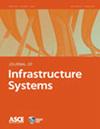出行需求不确定性和续驶里程异质性下的充电设施位置稳健设计
IF 2.2
3区 工程技术
Q2 ENGINEERING, CIVIL
引用次数: 7
摘要
受环保效益的推动,对电动汽车的需求不断增长,对电动汽车充电基础设施的需求也在增加。此外,人们也认识到,这些基础设施的完备性有助于促进电动汽车的使用。因此,为了促进电动汽车的普及,各国政府寻求对电动汽车充电基础设施发展的持续投资的指导。此类投资决策,包括电动汽车充电站的位置和容量,以及此类投资的时机,需要对未来出行需求和电动汽车电池续航里程的限制进行强有力的估计。考虑到未来出行需求预测的不确定性和电动汽车续驶里程的异质性,本文开发并实现了一个框架,在长期规划范围内建立新充电站和退役加油站的最优时间表和位置。提出了一种鲁棒数学模型,该模型既要最小化最坏情况下的系统总行程成本,又要最小化充电站未使用容量的总罚金。本文采用一种自适应的切面法来求解所提出的模型。基于两个关键决策标准(出行者成本和收费供应充足性),结果表明鲁棒性方案优于确定性方案。本文章由计算机程序翻译,如有差异,请以英文原文为准。
Robust Design of Electric Charging Infrastructure Locations under Travel Demand Uncertainty and Driving Range Heterogeneity
The rising demand for electric vehicles (EVs), motivated by their environmental benefits, is generating an increased need for EV charging infrastructure. Also, it has been recognized that the adequacy of such infrastructure helps promote EV use. Therefore, to facilitate EV adoption, governments seek guidance on continued investments in EV charging infrastructure development. Such investment decisions, which include EV charging station locations and capacities, and the timing of such investments require robust estimates of future travel demand and EV battery range constraints. This paper develops and implements a framework to establish an optimal schedule and locations for new charging stations and decommissioning gasoline refueling stations over a long-term planning horizon, considering the uncertainty in future travel demand forecasts and the driving range heterogeneity of EVs. A robust mathematical model is proposed to solve the problem by minimizing not only the worst-case total system travel cost but also the total penalty for unused capacities of charging stations. This study uses an adaptation of the cutting-plane method to solve the proposed model. Based on two key decision criteria (travelers’ cost and charging supply sufficiency), the results indicate that the robust scheme outperforms its deterministic counterpart.
求助全文
通过发布文献求助,成功后即可免费获取论文全文。
去求助
来源期刊

Journal of Infrastructure Systems
ENGINEERING, CIVIL-
CiteScore
6.10
自引率
6.10%
发文量
68
审稿时长
6 months
期刊介绍:
The Journal of Infrastructure Systems publishes cross-disciplinary papers about managing, sustaining, enhancing, and transforming civil infrastructure systems. Papers are expected to contribute new knowledge through development, application, or implementation of innovative methodologies or technologies.
Civil infrastructure systems enable thriving societies and healthy ecosystems. Civil infrastructure systems support transportation; energy production and distribution; water resources management; waste management; civic facilities in urban and rural communities; communications; sustainable resources development; and environmental protection. These physical, social, ecological, economic, and technological systems are complex and interrelated.
Increasingly, inter- and multidisciplinary expertise is needed not only to design and build these systems, but to manage, sustain, enhance, and transform them as well. Typical management problems are fraught with uncertain information, multiple and conflicting objectives, and sometimes numerous and conflicting constituencies. Solutions are both complex and cross-disciplinary in nature and require the thoughtful integration of sound engineering judgment, economic flexibility, social equity, and institutional forbearance.
Papers considered for publication must contain a well-defined engineering component and articulate a clear contribution to the art and science related to infrastructure systems. Potential authors should consult the ASCE Author Guide for acceptable paper formats and article types.
 求助内容:
求助内容: 应助结果提醒方式:
应助结果提醒方式:


